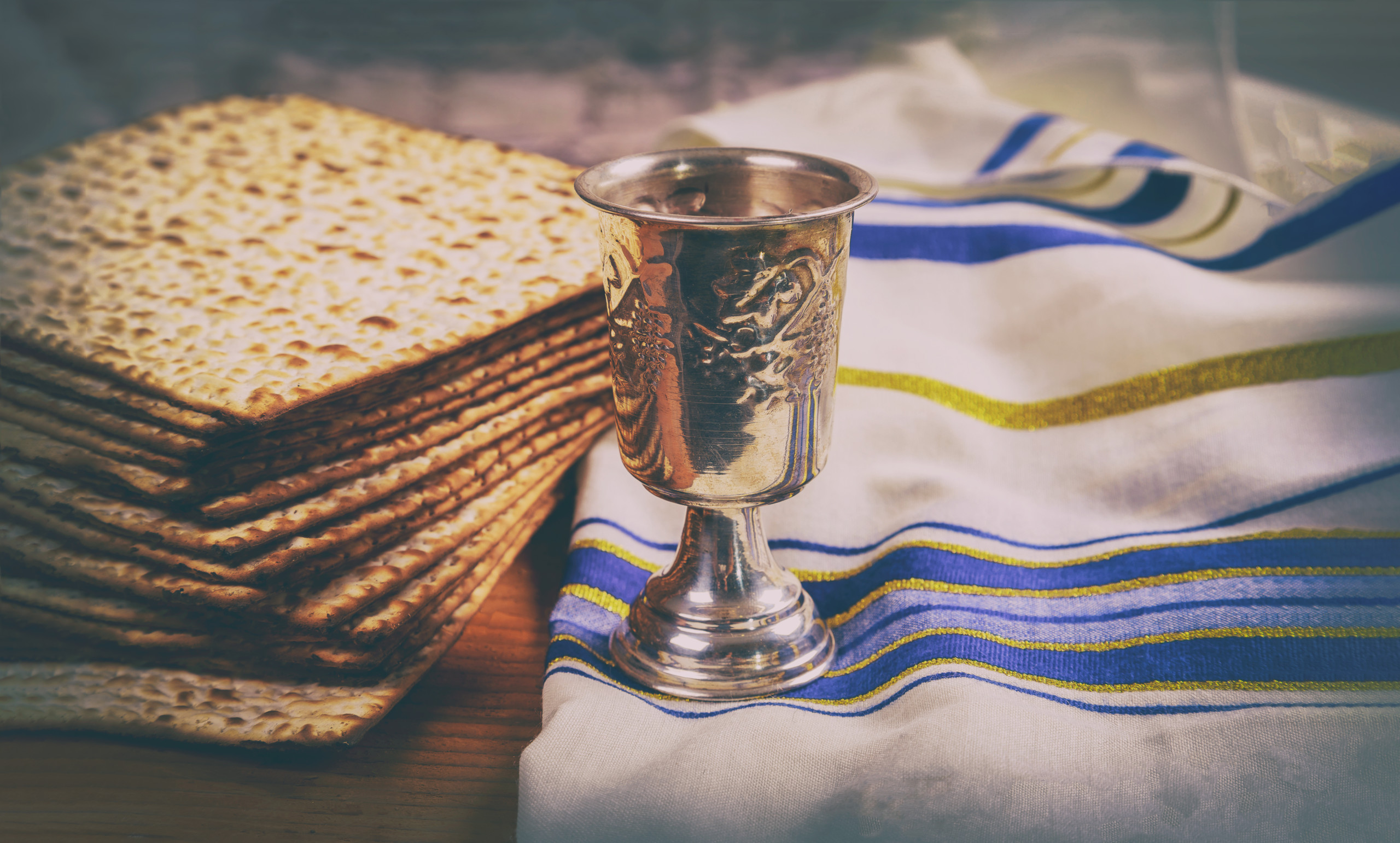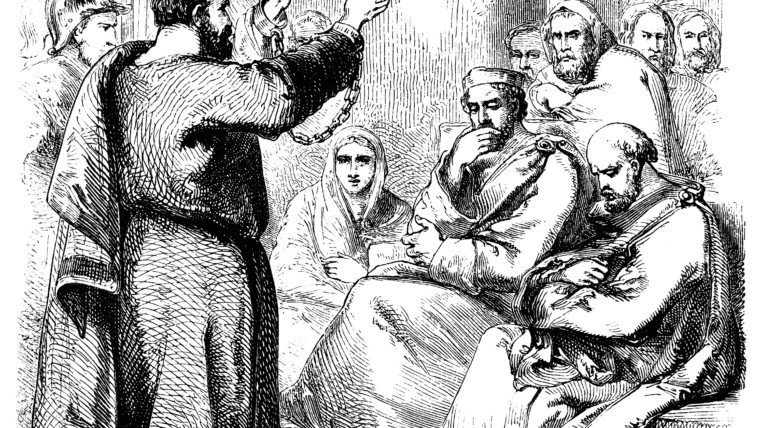The Quartodeciman Controversy
Rome Outlaws Passover
by Christine Egbert
In the footsteps of Paul Harvey–that folksy news commentator, whose radio segments delved into little-known facts about well-known events–this article will recount the history of what is known as the “Quartodeciman Controversy” (controversy of the 14th-ers) and the early church history leading to the disastrous decision of the Council of Nicaea to replace Passover with Rome’s Easter.
Ancient History
On page 42 of Earle E. Cairns book, Christianity Through the Centuries, first published by Zondervan in 1954, the author writes: “The Jews made possible a philosophy of history by insisting that history had meaning. They opposed any view that made history a meaningless series of cycles or a mere process of linear evolution. They upheld a cataclysmic view of history in which the Sovereign God who created history would triumph over man’s failure in history to bring about a golden age.”
In the next paragraph, the author goes on to say: “The Jews also provided an institution that was most useful in the rise and development of early Christianity. This institution was the synagogue.” In the synagogue, Cairns states, “Jews and many Gentiles were made familiar with a higher approach to life…it became the preaching house of early Christianity.” On page 55, the author writes: “…the gospel was first proclaimed in Jerusalem by Peter on the day of Pentecost; then it was carried by Christian Jews to other cities of Judea and Samaria. Consequently, the early church was primarily Jewish and existed within Judaism.”
One Faith – Many Sects
Robert Goldenberg, in his review of a book by Rabbi Daniel Boyarin, published in the Jewish Quarterly Review, pointed out that, “at the end of the 1st Century AD there were not yet two separate religions called ‘Judaism’ and ‘Christianity’.”
Talmudic scholar, Rabbi Daniel Boyarin, in his book Dying For God, Martyrdom and the Making of Christianity and Judaism, writes: “For at least the first three centuries of their common lives, Judaism in all of its forms and Christianity in all of its forms were part of one complex religious family, twins in a womb, contending with each other for identity and precedence, but sharing with each other the same spiritual food…Without the power of the orthodox Church and the Rabbis to declare people heretics and outside the system it remained impossible to declare phenomenologically who was a Jew and who was a Christian.”
Dr. James D. Tabor, Professor of Christian Origins and Ancient Judaism at the University of North Carolina, in his article “Jewish World of Jesus” writes the following: “Judaism in the time of Jesus is more properly designated ‘Judaisms’ as it can include a rich variety of forms and practices that flourished during late Second Temple times (200 BCE-70 CE). In one way or the other this diverse Jewish culture traces itself back to the Hebrew Bible and the history of the ancient Israelites. By Roman times, with the northern Ten Tribes long ago carried away into Assyrian captivity and largely lost to history, it became customary to refer to all those of Hebrew or Israelite ancestry who lived in the Roman Mediterranean world as Jews, and to their religious-cultural life as Judaism…”
In his article, the author explains that in 63 BCE, Roman general Pompey settled a dispute between two Maccabeans, siding with Hyrcanus II, and from that point forward, Israel came under Roman control, as administered by the imperial province of Syria. It was ruled by a military governor called a Legate. These governors maintained civil order, administered justice, and collected taxes, which they farmed out to local (non-paid) tax collectors, whose income consisted of whatever they collected in excess of Rome’s required tax. Their system left room for much abuse.
Rome, although oppressive in many ways, allowed the Jews exemptions from forced military service, from going to court on the Sabbath, from portraying the emperor’s head on their coins (which is why they needed money changers at the Temple), and most importantly from sacrificing to Rome’s deified emperor.
Imperial Cult
In the Imperial cult, Rome’s emperors (along with certain members of the emperor’s family), the Roman State and Rome’s official pagan deities were inseparable. Neglecting to worship the emperor, the state and all of Rome’s various gods was deemed an act of treason. During most of the 1st Century, Rome tolerated any religion, so long as that religion did not prohibit its followers from participating in Rome’s state system of worship. Jews alone were exempted from this strict mandate.
Destruction of the Temple
In 70 CE, forty years after Jesus’ (Yeshua’s) resurrection, the Jewish nation revolted against Rome. Their Temple was destroyed in fulfillment of the Messiah’s prophecy, and general Titus disbanded the Great Sanhedrin. With the Temple destroyed, there was no longer need for the Levitical priesthood. To make things worse, Emperor Vespasian levied a punitive tax (fiscus judaicus) upon all Jews, in the hope it might prevent them from funding another revolt. Later, Emperors Domitian and Hadrian increased this already burdensome levy. With the Temple destroyed, power shifted from the Sadducee wing of the Levitical priesthood to Pharisaic rabbis, and the synagogue quickly became the new center of Jewish life.
Second Jewish Revolt
In 132 CE, led by a man named Simon bar Kokhba, the Jews once again revolted against Rome’s harsh rule. The Nazarenes (Jewish Christians) fought for national independence alongside their non-Messianic Jewish brothers until Rabbi Akiva disastrously declared Simon bar Kokhba the Jewish Messiah, dooming the revolt through a loss of manpower. It was right to fight for national freedom, but unthinkable under the banner of a false Messiah, so all the Nazarenes withdrew.
Without the Nazarenes the revolt was quickly put down. From that point on Nazarenes were viewed as traitors, as lovers of Rome. In retaliation, Rome expelled all Jews from Jerusalem, their Holy City. That included the Nazarenes. Jews of every sect were banned from coming close enough to the city to even see it.
With Jerusalem now trodden only by Gentiles, Emperor Hadrian renamed it “Aelia Capitolina.” The surrounding area of Israel, he renamed Palestine (after Israel’s ancient enemies the Philistines), and on the sacred ground where the LORD’s (Yahweh’s) Temple once stood, Hadrian erected a Temple to Zeus. Judaism, once favored by Rome, in that Jews alone had been exempt from Rome’s mandated Emperor worship, was now an outlawed religion. Although Jews could no longer enter Jerusalem, history documents that most Jews continued to live in the surrounding areas which Rome had re-named Palestine, making Jews the original Palestinians.
Dr. Arnold Fruchtenbaum, a Jewish believer in Jesus (Yeshua), and Founder and Director of Ariel Ministries, has an interesting perspective. He writes: “If anyone can be blamed for turning Christianity into a Gentile religion it is bar Kokhba, and not Paul.” (Hebrew Christianity: Its Theology, History & Philosophy, page 42.)
One Faith Becomes Two
After the destruction of the Temple in 70 CE, a slow but progressive demise of the various sects indigenous to 1st Century Judaism began. Disciples of Jesus (Yeshua), referred to in Acts 9:2 as “the Way” became known as Netzarim (נְצָרִים Hebrew for the “offshoots of a branch”). That Branch was Jesus (Yeshua). Gentiles coming to faith stopped seeing themselves as members of the commonwealth of Israel (Ephesians 2) and adopted a name that had originally been bestowed on them as an epithet coined by scoffers. They were called Christians, a Greek word meaning a follower of Christ (the Messiah). From a Hebrew perspective you would say they were Messianic.
By the 4th Century those Jewish believers known as Netzarim were still practicing the faith that had been handed down to them by the original apostles. Epiphanius, the bishop of Salamis, Cyprus wrote the following near the end of the 4th Century:
“But these sectarians did not call themselves Christians, but “Nazarenes.” However, they are simply complete Jews. They use not only the New Testament, but the Old Testament as well, as do the Jews… They have no different idea but confess everything exactly as the Law proclaims it and in the Jewish fashion–except for their belief in Messiah. For they acknowledge both the resurrection of the dead and the divine creation of all things, and declare that God is one, and that His son is Yeshua the Messiah.
“They are trained to a nicety in Hebrew. For among them the entire Law, the Prophets, and the Writings are read in Hebrew, as they surely are by the Jews. They are different from the Jews, and different from Christians, only in the following. They disagree with Jews because they have come to faith in Messiah; but since they are still fettered by the Law–circumcision, the Sabbath, and the rest–they are not in accord with Christians… they are nothing but Jews… They have the Good News (gospel) according to Matthew in its entirety in Hebrew. For it is clear that they still preserve this in the Hebrew alphabet as it was originally written.” (Epiphanius; Panarion 29)
In chapter one of Redigging the Wells of Our Fathers, Larry M. Wishon points out the tragic fact that the changes in traditions made by the Western Gentile Church during the early centuries have been accepted by today’s mainstream Christianity as foundational to the faith, rather than what they actually were, departures from Apostolic doctrine. “In reality,” the author writes, “much of what was original to the early first century Church either disappeared at the beginning of the second century or was attired in a Babylonian garment and given a new name.”
By the end of the 1st Century many Christians no longer saw themselves as a sect within Judaism. Gentiles, by and large, detested Jews, whose Torah-observant lifestyle set them apart and made them targets. Gentile Christians, who were mostly untaught in God’s word, and were also a persecuted group at this time, hoped to garner favor from Rome by removing responsibility for Jesus’ (Yeshua’s) crucifixion from the Roman governor.
Many found it politically advantageous to blame only those Jews for Jesus’ (Yeshua’s) death. In reality, Jews had no authority to execute anyone, and Rome alone employed the horrific practice of crucifixion. Still, most Christians continued to worship as they had from the beginning, on the Sabbath and in synagogues, fellowshipping also in private homes. But with the passing of time, more and more Christians and Jews stopped defining themselves by the commonalities of their faith, choosing instead to magnify their evolving changes. Gradually what had been “one people of God with many sects” became two separate and very antagonistic religions.
This reactionary trajectory not only separated Christians from Jews over the next few centuries, it separated both faiths–Judaism and Christianity–from its original 1st Century form.
One of the first men to exacerbate this breach was a bishop in Sardis (Turkey). His name was Melito. In 167 CE he preached a sermon titled, “Homily on the Passover.” In it, he accused Jews as a whole of “deicide”, the murder of God. Some historians claim Melito’s goal was not to incite violence against the Jews, but to strengthen the identity of his parishioners as Christians. Either way, this set in motion an “us” versus “them” mentality, which in later centuries, when Christians had political power in Rome, was used to justify discrimination, persecution, and murder.
In the 3rd Century, Roman historian Dio Cassius noted a strange paradox. In spite of the fact that Jews were frequently persecuted, they seemed to somehow prosper.
He wrote:
“They succeeded in winning the right to observe their laws freely. They are distinguished from the rest of mankind in practically every detail of their way of life, and especially in that they honor none of the other gods but show extreme reverence for one particular deity. They never had a statue of him even in Jerusalem itself, but believing him to be unnamable and invisible they worship him in the most extravagant way among humans. They built him a large and splendid Temple… and dedicated to him the day called the day of Saturn [Saturday] on which, among many other most peculiar observances, they undertake no serious occupation.” Dio Cassius, 37.17, quoted in Robert L. Wilken, John Chrysostom and the Jews: Rhetoric and Reality in the Late 4th Century (Berkeley: University of California Press, 1983), 47-48.
A Growing Separation
When the Romans destroyed the second Temple in 70 CE, some Gentile Christians saw the destruction as a sign from God. In their view, it confirmed their belief that Christians were now the true Israel. They believed God allowed the Temple to be destroyed in order to punish Jews for rejecting Jesus (Yeshua).
Conversely, those Jews who did not believe Jesus (Yeshua) was the promised Messiah saw the Temple’s destruction as a sign they must more strictly observe the traditions of their Elders. The Temple’s destruction proved to these (non-Messianic) Jews that tolerance of sects had strengthened Rome’s oppression and harmed them as a people.
Constantine & the Edict of Milan
In 314 CE, Constantine and Licinius Augustus proclaimed the Edict of Milan: “…It has pleased us to remove all conditions whatsoever… concerning the Christians, and now any one of these who wishes to observe the Christian religion may do so freely and openly, without any disturbance or molestation.”
For Christians, this edict not only ended their savage persecution but granted Christians access to power. Until then, the church had met in private homes. Now they could practice their faith openly. Within a year of this edict Constantine ordered churches to be built throughout the empire. Many pagan temples, with their statuary of pagan gods, became Christian churches. All that changed was the names of the pagan deities. They became Catholic saints. (The one of St. Peter in the Vatican was originally Zeus.)
The Christian Church was now under Rome’s protection… and therefore Rome’s control. The first thing to go was gathering in private homes for worship. The next was the form of a service itself. Adopting the solemn pageantry of Rome’s Emperor Worship, still prominent in Roman Catholic masses today, two classes were quickly formed, the clergy and the laity.
But for the Jews, this new era of religious freedom brought condemnation and radically limited their rights as citizens of Rome. Exactly one year after the Edict of Milan, in 315 CE, Constantine issued another edict. This follow-up edict served two purposes: to prevent Jews from interfering with Christian converts and to prevent Gentile Christians from adopting any form of Judaism.
“We wish to make it known to the Jews, their elders and their patriarchs that after the enactment of this law, if any one of them dares to attack, with stones or some other manifestation of anger, another who has left their dangerous sect and attached himself to the worship of God [Christianity], he must speedily be given to flames and burn—together with all his accomplices.” Cited from “Laws of Constantine the Great, October 18, 315: Concerning Jews, Heaven-Worshippers, And Samaritans” from “Jews and Later Roman Law, 315–531 CE,” Internet Jewish History Sourcebook, Fordham University, Paul Halsall, http://www.fordham.edu/halsall/jewish/jews-romanlaw.html.
Birkat HaMinim
This ripping asunder of what was supposed to be One People of God came not only from the Gentile Church but from the Jewish Synagogue. In 90 CE, Rabbis at the Council of Jamnia added the Birkat HaMinim (12th of the 18 benedictions known as the Amidah).
Though this 12th benediction had been added specifically to curse disciples of Jesus (Yeshua), it cursed all heretics. And a heretic was now anyone holding beliefs that deviated from Pharisaic dogma. For after the destruction of the Temple, only Pharisees wielded power. With this power they narrowly redefined “who was” and “who was not” a Jew, birthing what today is called Rabbinic Judaism. Unlike the other benedictions said as part of the Amidah, only this 12th one was required to be recited out loud in the synagogue. No such regulation ever applied to the other seventeen. (Tanh. B., Lev. 2a).
How Easter Replaced Passover
Quartodeciman Controversy
155 AD
The Martyr Polycarp, a pupil of the apostle John, lived between 70 and 155 CE. As bishop of the church at Smyrna, Polycarp was one of the earliest combatants of Gnosticism and the heresies of Marcion, who taught, among other lies, that the LORD (Yahweh) was the “mean Creator god” of the Hebrew Bible–Scriptures which Marcion denounced as OLD and of no value to Christians. Marcion coined that term still used by the church today, Old Testament.
Consequently, during this period Roman Christians, who had never set foot in a synagogue or studied what they called the Old Testament, were unaware that the Almighty had strictly forbidden the name of a pagan deity ever crossing their lips (Exodus 23:13). So, in their ignorance, the Roman church began to call the day following the weekly Sabbath during First Fruits by the name of the pagan sun-goddess, Ishtar, which in English is pronounced Easter.
Between the churches of Asia Minor in the east and those of Rome in the west, Easter became a divisive issue. Polycarp, the bishop of Smyrna, who had been discipled by the apostle John himself, argued for continuing to observe the Messiah’s death on Passover, the 14th of Nisan, the Feast of Unleavened Bread on the 15th, and Jesus’ (Yeshua’s) resurrection on the day following the weekly Sabbath (during the Passover week), a day known in Scripture as First Fruits. This was the way Jesus (Yeshua) had taught the apostle John, and John had taught Polycarp. And it was the way the 1st Century church had always commemorated the event.
The Bishop of Rome, Anicetus, saw it differently. Wanting to distance himself from those Jews, he insisted the entire church (east and west) should commemorate the resurrection the way they did it in Rome (from whence, I am certain, came the motto: “When in Rome, do as the Romans”).
They Agree to Disagree
Rome’s Bishop could not convince Polycarp, the Bishop of Smyrna, to change. Nor could Polycarp convince Anicetus. So, in the spirit of love, they agreed to disagree. Rome continued to celebrate Easter Sunday and believers in the assemblies of Asia Minor–now smeared by the Romans as Quartodeciman, fourteenth-ers–held fast to the instructions Polycarp received from the apostle John.
The Bishop of Ephesus
Versus
The Bishop of Rome
Several decades later, in 195 CE, a Bishop of Ephesus named Polycrates argued with Victor, another Bishop of Rome, over this very same dispute (but this time with a different outcome) as recorded by the historian Eusebius:
“There was a considerable discussion raised about this time, in consequence of a difference of opinion respecting the observance of the paschal [Passover] season. The churches of all Asia, guided by a remoter (an older) tradition supposed that they ought to keep the fourteenth day of the moon (Nisan) for the festival of the Savior’s Passover, in which day Jews were commanded to kill the paschal lamb… The bishops of Asia who persevered in observing this custom handed down to them from their fathers, were headed up by Polycrates, who indeed, had also set forth the tradition handed down to them, in a letter which he addressed to Victor and the church of Rome.
‘We,’ said he, ‘therefore, observe the genuine day; neither adding there to nor taking there from. For in Asia great lights have fallen asleep, which shall rise again the day of the Lord’s appearing, in which He will come with glory from heaven, and will raise up all the saints …Moreover, John, who rested upon the bosom of our Lord, and also Polycarp of Smyrna, both bishop and martyr …Thraseas, …Sagaris, …Papirius, and Melito …All these observed the fourteenth day of the Passover according to the gospel, deviating in no respect, but following the rule of faith. Moreover, I, Polycrates, who am the least of all of you, according to the tradition of my relatives, some of whom I have followed. For there were seven of my relatives [who were] bishops, and I am the eighth; and my relatives always observed the Day when the people (i.e., the Jews) threw away the leaven.”
Victor, the Bishop of Rome, sought to excommunicate Polycrates and all Christians who dared to hold fast to the biblically commanded observance of the 14th of Nisan. But after Irenaeus and some others interceded on Polycrates behalf, Victor finally relented. But make no mistake, Polycrates’ letter proves that the Churches of Asia Minor never accepted Rome’s authority.
By the 4th Century, when Constantine convened the Council of Nicaea, there were even more Gentiles (Jew-haters) in the Christian Church. No one remembered, or cared, how the early Church did things. All the remaining Quartodeciman (14th-ers) had lost their earlier influence.
During the council of Nicaea, in which no Jewish believers were allowed to participate, many topics were dealt with. Many disputes were resolved with good outcomes. But that Council’s decision regarding Passover and Easter began a process finalized a few decades later at the Council of Laodicea, which severed mainstream Christianity from its Hebraic roots. That separation, along with the Roman Catholic Church’s self-proclaimed right to “add to and take away” from Scripture, to redefine the established orthodoxy taught by Jesus (Yeshua) to His apostles, launched the world into what historians call the Dark Ages.
Urged by Christians in Alexandria, the Roman Emperor Constantine at the Council of Nicaea ruled that Easter, which up to then had been observed on the Sunday following the weekly Sabbath, during the Feast of Unleavened Bread (First Fruits), was to be celebrated, by all churches, on the first Sunday after the spring equinox (the day on which Ishtar, the sun-goddess, was said to have landed in the Euphrates in a giant Ishtar-egg), regardless of when the Jewish (biblical) Passover fell. And Christians, from then on, were forbidden by Rome to observe Passover or to have any fellowship with those “detestable Jews”.
To celebrate this new State-Church ruling, Constantine waged a vile anti-Semitic attack against all 14th (Quartodeciman) proponents, ordering the severest of punishments (death) on those who failed to comply. But in spite of this, it was several centuries before Rome’s edict became a standard throughout Christendom. And that, my dear readers, as Paul Harvey would say, is the rest of the story, the TRUE story of how the Christian Church started celebrating Easter.



